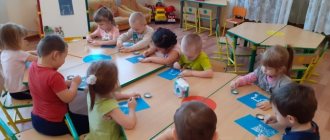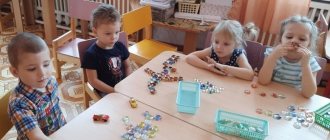Federal State Requirements
At the same time, these requirements are aimed at achieving several other goals. Integrated classes in the first junior group on FGT should be conducted according to the following principles:
- Teaching cultural and historical values.
- Activity-personal approach.
- Development of intelligence and physical culture.
- Formation of desire and desire for learning in preschool children.
- Formation of a general culture of behavior in a child.
- Education does not hammer facts into children's heads, but develops and scientifically substantiates them.
- The unity and importance of all the tasks that a teacher faces: education, development, training.
- Joint and independent classes.
- As a result of mastering the program, the child acquires various qualities.
Thus, integrated classes in the first junior group of kindergarten in FGT come down to the formation of an individual who will join modern society and behave like everyone else, but at the same time retain his individuality and difference from others.
Integrated final lesson in the first junior group Topic: “Toys”
Educational areas: “Cognitive development”, “Speech development”, “Fiction”, “Artistic and aesthetic development”
Tasks:
- Strengthen children's ability to distinguish colors (red, blue, green, white), knowledge of geometric shapes (circle, square).
- Strengthen the ability to recite a poem by clearly pronouncing the words.
- Form an idea of size: big, small.
- Strengthen the ability to draw with non-standard material (ear sticks).
Material: horse, bag, ribbons (red, blue, green, white); cones, basket (large, small), toys, white gouache, butterfly, butterfly blanks, sticks, umbrella, geometric shapes (circle, square).
Vocabulary work: neighs, cones, mushrooms, circle, square, ribbons.
Individual work: reciting the poem in full words with Sasha, Dima, Gelya.
Contents of organized educational activities for children.
Surprise moment. - Guys, listen, is someone coming to us? (A horse rides in with a beautiful red bag). Children, look who came to us? (Horse.) Dima, read a poem about a horse?
“I love my horse, I will comb its fur smoothly...”
- Guys, the horse is very happy that you told him the poem. And how she laughs “Igo-go.” Look, she brought you a big beautiful bag, and from this bag you can see ribbons of different colors. What color is this ribbon? (red) let's see who has this ribbon. Guys, this is a bunny. (The bunny is wet.) Who knows what happened to the bunny? (He got wet.) Why do you think he got wet? And now Sasha will tell a poem about a bunny.
“The mistress abandoned the bunny...”
Guys, how can you help the bunny so that next time the rain doesn’t get him wet? (Give an umbrella). He has an umbrella, look, it’s all full of holes, how can you fix it?
Game "Fix the umbrella".
- I’ll give you patches, what do they look like? (On the figures.) What figures. (Circle, square.) Look, I also have an umbrella with a hole. I take a circle and fit it onto a hole in the shape of a circle, similarly with a square. Take the pieces and fix the umbrella.
- Guys, the bunny is very happy! He says thank you! Let's look at another ribbon, what color is it? (Blue.) Danil, tell me a poem about a bear?
“They dropped the bear on the floor...
- Guys, the bear didn’t come alone, his friend came with him. What are they like, look at them? (One is big, the other is small.)
Didactic exercise “Many - One”.
- Guys, when the bear was collecting cones and mushrooms in the forest, a cone fell on his forehead, and the bear tripped over a mushroom, now the bears are afraid to collect cones and mushrooms in the forest, let's help them collect cones and mushrooms. They brought two baskets with them, which one basket? (large), and the other? (small). Guys, how many big baskets are there? (One.) How many small baskets? (One). And there are so many (many) cones and mushrooms.
Outdoor game “Collect cones and mushrooms.” — Guys, you need to collect the cones in a large basket, and the mushrooms in a small one. Well done for helping the bears, they couldn’t have done it without you.
- What color is this ribbon? (Green.) Let's see, whose ribbon is this? Who are these guys? (Butterfly.) Guys, the butterfly was in the bag and tired, it needs to stretch its wings. Let's play with her.
Physical exercise “Butterfly”. In the morning the butterfly woke up, smiled, stretched, once - she washed herself with dew, two - she circled gracefully, three - she bent down and sat down, and flew away on four.
"Butterfly. Drawing dots with ear sticks." Guys! While the butterfly was sitting in the bag, the dots on its wings all spread out. Let us help them. Stand around the tables. Watch me make dots with chopsticks. I take a stick, pick up some white paint and put dots on the wings. This is such a beautiful butterfly. Independent work.
What beautiful butterflies you have created.
- Look, the horse has one more ribbon left, what color is it? (White, like the dots on a butterfly.)
The teacher takes out a small bag and asks the children. Guys, what does a horse like to eat: grass, grain, straw. The horse has prepared a treat for you. He takes out a straw treat from his purse. Let's say thank you to the horse.
General requirements
According to federal and state education standards, there are no specific requirements for conducting classes. For the most part, they are advisory in nature.
- Interaction between teacher and student. This implies continuous contact between the child and the preschool employee. You cannot give your children a task (for example, make a craft from plasticine) and go watch your favorite series on TV. It is necessary to control the creative process.
- Most learning should be done through play. It is clear that such activities need to be prepared in advance, and kindergarten employees have a small salary to spend time at home on organizing events, but at least occasionally give the children an adventure.
- Gender approach. Foster in children a sense of equality between the sexes. If boys have to do physical exercises, then the female half of the students too, if you keep the girls busy with needlework, then put the boys in similar work.
- Versatility. The development of children should be comprehensive, so that by the time they leave school they have an understanding of different areas of life and can independently choose the path of interest; this is why integrated classes are needed in the first junior group. Be it an artist, a builder, a businessman or an electrician.
- Unity. All students upon graduation from preschool educational institutions must have the same skills. An educator cannot teach only a select few, guided by subjective opinion. Everyone should have equal opportunities when entering school.
Example lesson
What exactly should kids do in kindergarten? Standards are not the most important thing. The process itself plays a decisive role in integrated lessons. Let's look at the situation using a clear example.
The first younger group is still just kids. They only learn to count, write, and study the world around them. And nothing but integrated classes will help them. You can start, for example, by combining mathematics, the Russian language and the surrounding world. Buy a special alphabet for preschoolers. It will be depicted on a large Whatman paper, next to it there will be beautiful pictures of animals, trees and other objects that surround us. Moreover, the number of, for example, elephants near the letter “C”, kittens near “K” (and so on) will be different. Now start learning the alphabet with your kids by asking who is in the picture and in what quantities. If difficulties arise, please help. By going through the entire alphabet, you will help children get used to counting. Plus, kids will learn to call the things around us by their proper names, practice their fragile speech, and also develop reading and Russian language skills. This approach (combining mathematics, the outside world and speech development) is very popular. Usually, teachers read fairy tales with children and, showing pictures, ask the children to describe the picture that is happening and count everything that is shown in the picture.
What to choose?
Despite the fact that FGT and Federal State Educational Standards are two different quality standards that are used in different age categories, some kindergartens (especially private ones) may use certain teaching methods. Everyone knows the problems with queues for places in these institutions in our country, but if you have the opportunity to choose, what is better? No assessment can be objective. You just need to know that integrated classes in the first junior group, conducted according to the FGT system, will make your child an independent person who will harmoniously integrate into modern society. While GEF classes at such an early age can break your child, and as a result he will lose all desire to learn, which will lead to him becoming just another brick in the wall.




